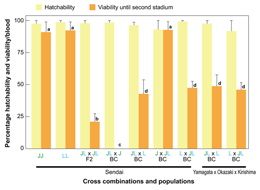Research Abstract
遺伝子流動が生じても生態型の融合を阻止する遺伝学的機構
Genetic mechanisms preventing the fusion of ecotypes even in the face of gene flow
2012年7月12日 Scientific Reports 2 : 506 doi: 10.1038/srep00506

適応と生殖隔離の背景にある遺伝学を理解することは、どのように生物多様性が生み出され、維持されるのかを知ることにつながる。植食性昆虫の寄主品種(host race)は宿主と結びついた生態型であり、生態的種分化の対象であると考えられているが、宿主適応の遺伝学的背景についてはほとんどわかっていない。潜葉性のガであるクルミホソガ(Acrocercops transecta)には、クルミ(Juglans-)に特化した寄主品種と、ネジキ(Lyonia)に特化した寄主品種が存在する。本研究では、2つの寄主品種間のF1とF2、および戻し交配を行った交雑個体を用いて、産卵選好性と幼虫の生育適性の遺伝学的基盤を評価した。交雑世代の分離パターンは、幼虫の生育適性についてはクルミに対するものが優性を示したが、産卵選好性はネジキに対するものが優性だった。この結果は、交雑幼虫個体がクルミで生育可能であっても、ネジキ種から遺伝子移入される遺伝学的要素が、クルミ種から除去されることを示している。つまり、寄主適応形質において対照的な優性の方向性を示す単純な遺伝学的制御が、寄主品種の融合を阻む障壁として作用しているのである。
大島 一正1,2,3*
- 北海道大学大学院 農学研究科
- 基礎生物学研究所 生物進化研究部門
- 京都府立大学大学院 生命環境科学研究科
*現在の所属: 京都府立大学大学院 生命環境科学研究科
Understanding the genetics behind adaptation and reproductive isolation contributes to our knowledge about how biodiversity is created and maintained. Host races of phytophagous insects are host-associated ecotypes and have been considered as candidates for ecological speciation, but very little is known about the genetic backgrounds of host adaptations. A leaf-mining moth, Acrocercops transecta, consists of Juglans- and Lyonia-associated host races. This study assesses the genetic bases of oviposition preference and larval performance using F1, F2 and backcross hybrids between the two host races. Segregation patterns in the hybrid generations revealed that larval performance on Juglans is dominant, but oviposition preference for Lyonia is dominant. This result indicates that genetic components introgressed from the Lyonia race are removed from the Juglans race even though hybrid larvae are viable on Juglans. Thus, simple genetic controls with contrasting dominance directions in host-adaptation traits function as barriers to prevent a fusion of host races.

